The Best Work Order Software
Work order software simplifies scheduling, service requests, and task management. We’ve identified the top tools for various industries, whether you’re a multi-site manufacturer or a small field service company.
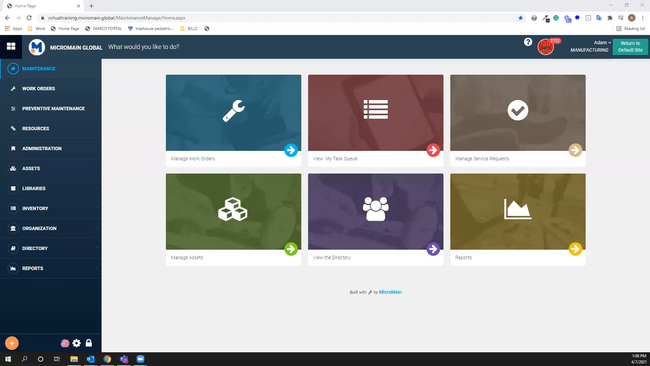
- Add spare parts and labor costs to WOs
- Choose between different maintenance types
- Reporting and KPI tracking
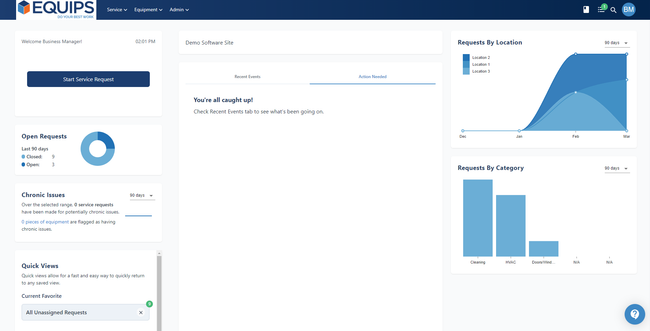
- Configure dispatch for equipment
- Easy to navigate UI
- Automatically assigns dispatch to requests
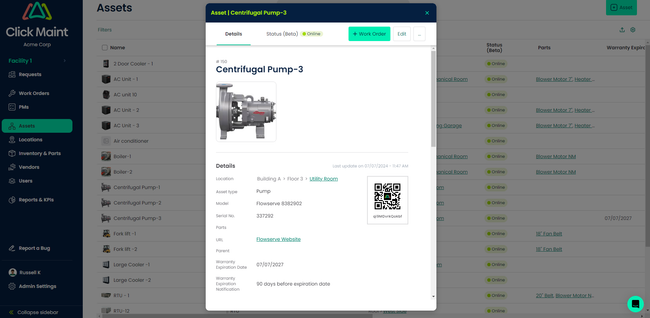
- Affordable pricing for SMBs
- PM scheduling
- KPI tracking for job costing
Our picks support several industries, including manufacturing, field services, and property management, helping to increase efficiency and reduce maintenance costs.
| Problem | Feature | System | Starting Price |
|---|---|---|---|
| Unorganized work orders | Detailed work order management | Click Maint | $35/user/month |
| Ensuring maintenance is correctly assigned | Equipment manager | Equips | $50/user/month |
| Inefficient maintenance request forms for property tenants | Service requesting module | FMX | $3,000/year |
| Double-booking for field service jobs | Scheduler and dispatcher tool | Jobber | $39/user/month |
| Requesting and performing maintenance without a desktop | Work order mobile app | MaintainX | Free, $16/user/month for paid plan |
| Lengthy machine downtimes | Multi-site work order scheduler | MicroMain | $99/user/month |
| Error-prone PM checklist creation | Smart Import Checklist Generator | UpKeep | $45/user/month (Starter plan) |
| Reactive maintenance delays | Native sensor-based automation | eMaint | $69/user/month (Team plan) |
- MicroMain: Best for Manufacturing
- Equips: Best for Equipment Management
- Click Maint: Most Affordable
- Jobber: Best for Field Services
- MaintainX: Best Mobile App
- FMX: Best for Property Management
- UpKeep: Best PM Checklist Generator
- eMaint: Best Predictive Work Order Generation
MicroMain - Best for Manufacturing
MicroMain’s work order scheduler allows manufacturers to create detailed WOs for all production equipment. The system offers multi-site support for larger operations, and you can specify which site and shop you’re located in. You can also select the maintenance category of the order, whether it’s corrective, preventive, or even predictive. This is crucial for ensuring proper classification during audits and scheduling tasks.
While creating a work order, the resources tab lets you add additional costs for better planning. Because it syncs with its spare parts inventory module, you can easily include all necessary components and their estimated costs for the repair. Also, the part isn’t taken out of inventory until the work order is completed for better accuracy. This helps plants with complex machinery plan maintenance more efficiently to reduce overall downtimes.
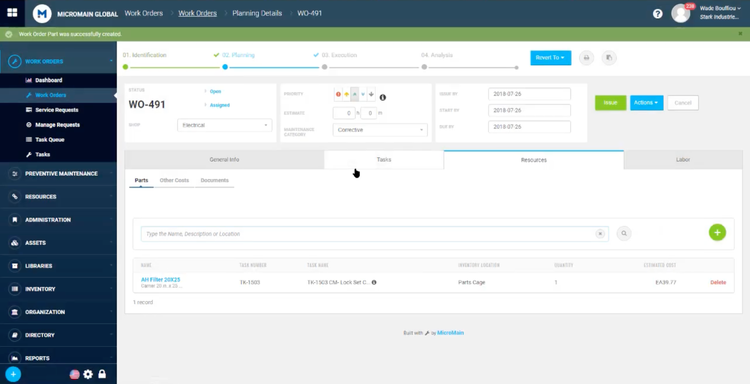
Additionally, the system stores all work orders for complete KPI reporting and maintenance history. Especially for food and beverage manufacturers, having a well-documented maintenance history is essential for compliance with 21 CFR Part 11. Even for job shops and discrete manufacturing, MicroMain organizes past work orders to help evaluate metrics like mean time between failures (MTBF) and mean time to repair (MTTR).
MicroMain is an effective option for mid to large-sized multi-site manufacturers. Its pricing starts at $99/user/month, which may be too steep for small job shops. Click Maint or MaintainX offer more affordable pricing, but less scalability.
Read our MicroMain review for more info.
Equips - Best for Equipment Management
The equipment management module in Equips helps companies of various industries track maintenance. For example, it lets you configure the dispatch preference for each asset, making it much easier to assign the correct technician for the job. Whether you’re a financial institution needing an ATM repair or a restaurant with a broken dishwasher, this system ensures you assign the correct specialist to reduce downtime.
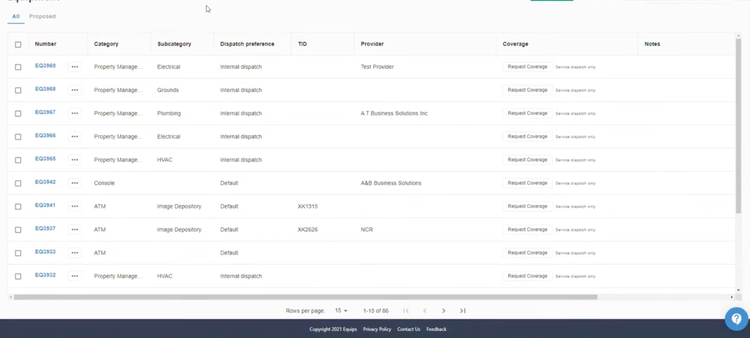
You can link all equipment in the system to service requests for better organization. When creating a request, you can search for the equipment that needs maintenance by name or group. From there, Equips automatically assigns the dispatch to the preference listed for that specific asset, whether it’s internal or external providers.
Equips uses a quote-based pricing model, with subscriptions starting at $50/user/month. It works best for companies managing several pieces of specialized equipment or facilities that require maintenance, like financial institutions, service providers, or restaurants.
See our Equips profile page for more.
Click Maint - Most Affordable
Click Maint’s all-in-one plan is $35/user/month for small to mid-sized businesses. While its price is low, it doesn’t lack functionality, as evidenced by its easy-to-use work order module. The list view provides a detailed record of all open and in-progress WOs. You can filter these by priority, ranging from low to critical, assigned date, due date, or location. This ensures more pressing tasks don’t get left behind.
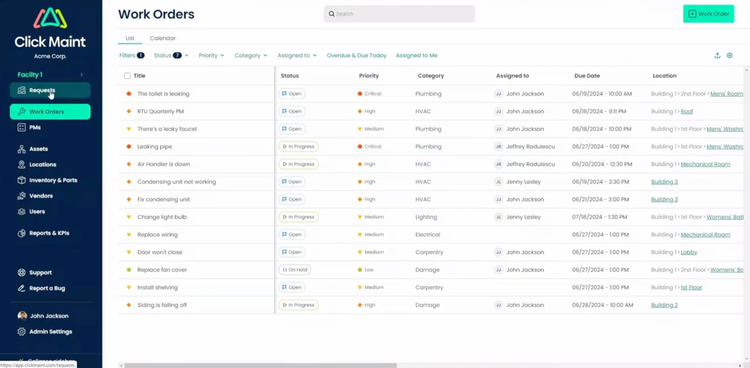
For recurring jobs, Click Maint lets you schedule preventive maintenance. For instance, you can set custom triggers on assets like CNC machines or mixers to auto-generate a work order when they exceed the threshold of production hours or cycles. From there, add all necessary information, checklists, or equipment manuals. This way, it will auto-populate into the list or calendar with the correct priority, helping you automate scheduling.
Additionally, the system organizes your work order history and consolidates data into reports for accurate time and cost tracking. Analyze KPIs to see total labor costs across your company and drill down into specific jobs to identify outliers. For example, if you have an unusually high parts cost at the end of the month, you can see exactly which ones were used, like a new control panel or motor for heavy machinery repair. This gives you total visibility into your maintenance operations to keep technicians accountable and create better-informed decisions.
Learn more in our full Click Maint review.
Jobber - Best for Field Services
Jobber offers efficient scheduling and dispatching tools to optimize field service operations. The integrated online booking system automatically schedules new jobs in a shared calendar for easy viewing. You can edit daily tasks for each team member by dragging and dropping them into specific hour slots or by stretching the length. You can also assign jobs in open slots, helping you optimize daily schedules to avoid double booking or overworking field crews.
The scheduler doesn’t stop at the calendar view; it provides an interactive map that shows routes, scheduled tasks for the day, and filters like job type. This is especially useful for field service teams that perform anytime visits scheduled for a specific day but not a time. For these, you can order by location for optimal routes and minimal travel time.
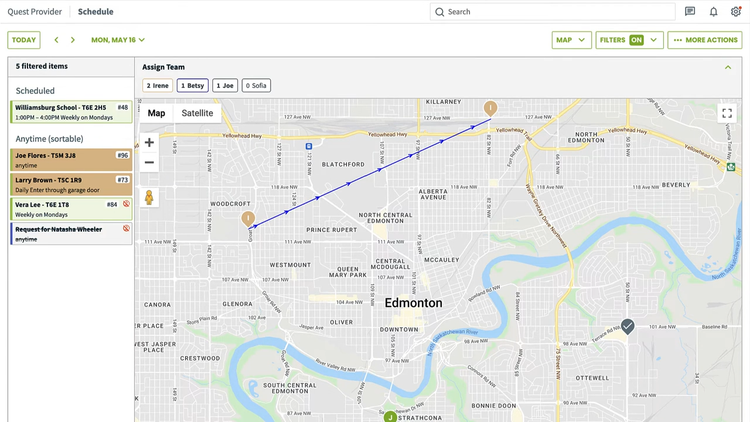
Built for small businesses and startups, Jobber’s pricing starts at $39/month for a single user when billed annually. However, if you’re a multi-location operation, Jobber may be too basic for your needs. Visit our full list of field service software for other options.
Visit our Jobber product profile.
MaintainX - Best Mobile App
MaintainX’s mobile app is effective for both maintenance requesters and technicians. As a requester, you can quickly submit work orders on your mobile device. Add a title, pictures, a description, and set priority. At the bottom, you can assign the location and asset from the database and include any necessary associated files. MaintainX keeps the entire process on one screen, letting you go step-by-step. Once completed, it will instantly show up in the “my requests” tab so you can review, edit, or cancel the work order.
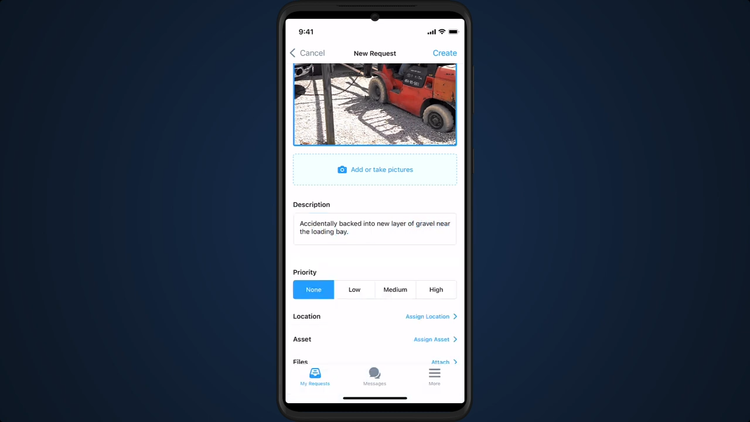
The mobile app automates processes for technicians, too. From the home screen, you can view all tasks assigned to you, including overdue and high-priority WOs. Once you select the one you’re working on, all the necessary information is included on the main screen, and you can start the timer to track time. It even has offline access, so you can complete jobs without internet or cellular service, which is essential for continuity.
The mobile app also includes a built-in messaging section for requester and technician communication. Either party can leave comments for specific work orders, whether it’s additional information or an acknowledgment that the issue will be resolved. This makes it easier for crews to perform maintenance and results in faster completion times.
MaintainX is one of the most affordable systems on the market. Its free plan offers unlimited work orders and requester users, making it suitable for small manufacturing job shops or single-entity facility management. However, you can only add images on the Essential plan at $16/user/month, which is still a good value.
Read our full MaintainX review.
FMX - Best for Property Management
FMX service requesting module allows your tenants to submit requests for you to review, whether commercial or residential properties. These requests cover different categories, including maintenance, cleaning, incident, and IT. This helps you immediately assign the right technician when you create the corresponding work order.
Based on the type the user selects, corresponding questions will automatically appear. For example, if it is a heating and cooling issue, questions like “Is the fan running?” or “Is the system turned on?” auto-populate. These are meant to address easily resolved issues, helping you lower maintenance labor costs.
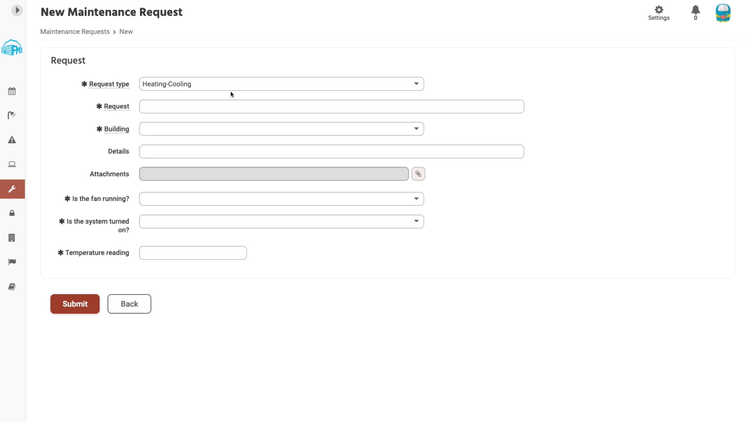
The service requesting module consolidates all data into a real time KPI dashboard. This breaks down important metrics such as:
- Maintenance costs: Combines all properties’ labor, inventory, and miscellaneous expenses for maintenance.
- Total cost by request type: Identify the most expensive requests to resolve and analyze trends. These can be issues like heating, refrigeration, or general maintenance.
- Team performance: See how efficient your crews are with average response time and average resolution time statistics.
Learn more information on FMX’s product profile.
UpKeep - Best PM Checklist Generator
UpKeep’s smart import checklist generator lets you create preventive maintenance checklists just by uploading OEM manuals or PDFs. The software uses natural language processing (NLP) to extract step-by-step guidelines related to calibration, safety protocols, maintenance, or inspections. From there, UpKeep converts them into standardized task lists for your recurring work orders.
You can review, edit, and directly tie the checklists to work orders, which saves your team a ton of time manually setting up each asset. UpKeep even lets you trigger checklists on a runtime/meter-based or time-based schedule. Recent updates refined the algorithm even further to prevent hallucinated or invented steps. This means only verifiable, documented tasks appear in your checklists, vital for compliance in industries like manufacturing and healthcare.
UpKeep starts at $20/month per user for unlimited work orders and recurring work orders. However, you’ll need to spring for the Starter plan at $45/month per user for custom checklists and preventive maintenance optimization. As a work order software for small businesses, UpKeep is generally best for compliance-heavy environments or large asset inventories.
eMaint - Best Predictive Work Order Generation
Where most CMMS rely on manual triggers or fixed schedules, eMaint offers condition-based maintenance with zero third-party integrations. It uses proprietary, industrial-grade sensors from its parent company, Fluke, to monitor real-time asset conditions, from vibration and temperature to power load and pressure.
Because Fluke sensors are natively integrated with eMaint, asset data flows directly into the CMMS, no custom coding or middleware required. Your maintenance planners can set thresholds for equipment; if a sensor reading breaches a threshold, eMaint automatically creates a work order and applies workflow rules, like:
- Assigning it to a specific technician
- Attaching standard procedures or documents
- Requiring approval before execution (if desired)
These WO workflows are fully customizable, so you can automate everything or maintain oversight where needed. In either case, this means no manual handoff; techs can log in and see a work order already in their queue, complete with sensor data, instructions, and asset history.
Pricing starts at $69/user/month for the Team plan, though you’ll need the Professional plan at $85/user/month for automated workflows.
What is Work Order Software?
Work order software allows you to create a trackable document identifying what work needs to be done and how it should be accomplished. It aims to streamline workflows from initial service request to completion, with equipment tracking, cost monitoring, and dispatching. These systems are subsets of a more comprehensive CMMS or maintenance management software and are often interchangeable.
Common Challenges
- Unorganized request process: Manual maintenance request systems are inefficient, can cause delays, or lead to miscommunication. High-priority tasks can be quickly lost within a fast queue.
- Missed deadlines: Poor scheduling and prioritization can lead to bottlenecks and double bookings, resulting in missed deadlines.
- High maintenance costs: Lack of visibility into jobs and unclear accountability can lead to increased maintenance costs. Also, technicians may face delays without access to important information before starting the job.
- Increased downtimes: Inefficient work order processes lead to increased machine and equipment downtimes, which cuts into profit.
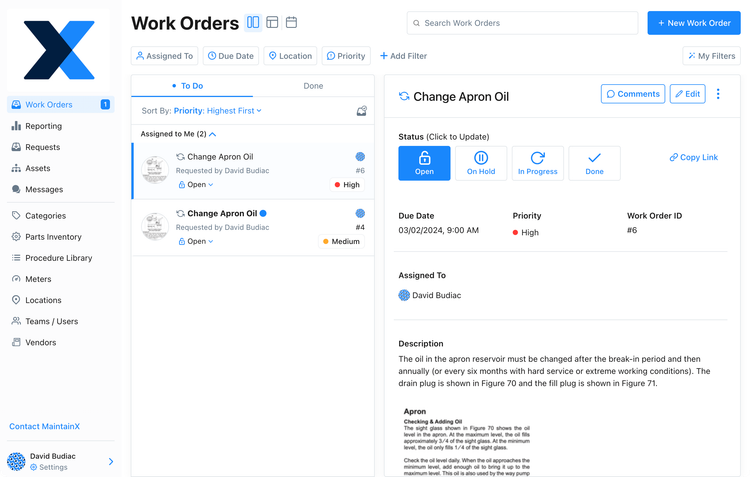
Key Features and Benefits
| Feature | Description | Benefit |
|---|---|---|
| Service requests | Let users create work order requests using templates or from scratch. Upload pictures, add locations, and complete descriptions of the problem. | Helps employees solve their problems faster and provides more details for your technicians. |
| Scheduling | Schedule all work orders based on time, priority, and technician availability. | Avoid double-booking or overworking maintenance crews; complete critical tasks first and minimize downtimes. |
| Reporting | Consolidate work order data like turnaround time and completion percentage; monitor KPIs on a dashboard. | Visualize maintenance crew performance and see the average time between approval and completion; identify trends in data. |
| Mobile app | Submit service requests and complete work orders and inspections on your mobile device. | Provide flexibility for requesters and technicians; lets you document problems from anywhere, even without Wi-Fi access. |
| Equipment management | Maintain a database for all equipment that requires maintenance. | Select the proper asset when submitting requests and give technicians access to the correct details and information. |
| Approvals | Configure single or multi-level approval processes for work orders. | Only select users can approve or deny work orders for better control. |
| Job tracking | Track job statuses in real time; receive updates for task completion or if additional work is required. | Gain visibility into the work on assets and equipment to get up and running as soon as possible. |

Pricing Guide
Work order software prices range from $3,000 to over $80,000/year depending on the type of system you require and your user count.
| Tier | Typical Annual Cost |
|---|---|
| Low | $3,000 – $10,000 |
| Mid | $10,000 – $30,000 |
| High | $30,000 – $80,000 |
| Enterprise | $80,000+ |
- CMMS: These systems, like MaintainX and Equips, can range from $0-$120/user/month and offer tiered pricing models, which increase in price as they add more features.
- Field service management: Pricing is similar for these systems, with most generally starting at $20-$75/month. For example, Jobber’s lowest plan starts at $39/month for 1 user, and its Grow plan costs $200/month for 15 users.
| System | Software Type | Starting Price | Free Trial |
|---|---|---|---|
| Click Maint | CMMS | $35/user/month | 30-day |
| Equips | CMMS | $50/user/month | ❌ |
| FMX | CMMS | $3,000/year | ❌ |
| Jobber | Field service management | $39/user/month | 14-day |
| MaintainX | CMMS | Free, $16/user/month for lowest paid plan | Forever free version |
| MicroMain | CMMS | $99/user/month | ❌ |




















































